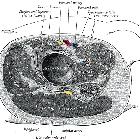Gluteus maximus



An anatomical
illustration from the 1909 edition of Sobotta"s Atlas and Text-book of Human Anatomy with English terminology.

Muscles of
the gluteal and posterior femoral regions with current muscle highlighted

An anatomical
illustration from the 1909 edition of Sobotta"s Atlas and Text-book of Human Anatomy with English terminology.

Gluteus
medius muscle • Gluteal and posterior thigh muscles (Gray's illustration) - Ganzer Fall bei Radiopaedia
The gluteus maximus (plural: glutei maximi) is the largest muscle in the gluteal region and overlies most of the other gluteal muscles.
Summary
- origin
- gluteal surface of the ilium behind the posterior gluteal line
- the lumbar fascia
- lateral mass of sacrum
- sacrotuberous ligament
- insertion: gluteal tuberosity of the femur and iliotibial tract
- gross anatomy:
- thick flat sheet of muscle sloping from the pelvis down across the buttock
- fan-shaped muscle with a posterior third lying deep to the posterior recess of the ischioanal fossa
- action
- powerful extensor of flexed femur at hip joint
- lateral stabilizer of hip joint
- lateral stabilizer of the extended knee joint
- by tightening the iliotibial tract
- lateral rotator of the thigh
- abduction at the hip (upper fibers)
- arterial supply: superior and inferior gluteal arteries
- innervation: inferior gluteal nerve (L5, S1, S2)
bursa:- between the muscle and ischial tuberosity (ischiogluteal bursa)
- between the muscle and greater trochanter (trochanteric bursa)
- between the muscle and upper part of the vastus lateralis (gluteofemoral bursa)
- antagonist
- variants
- fusion of gluteus maximus with tensor fascia latae
- additional slip of muscular attachment to the gluteus maximus from the ischial tuberosity
Siehe auch:

